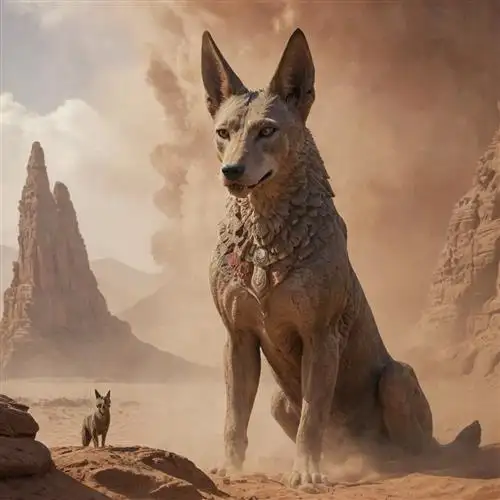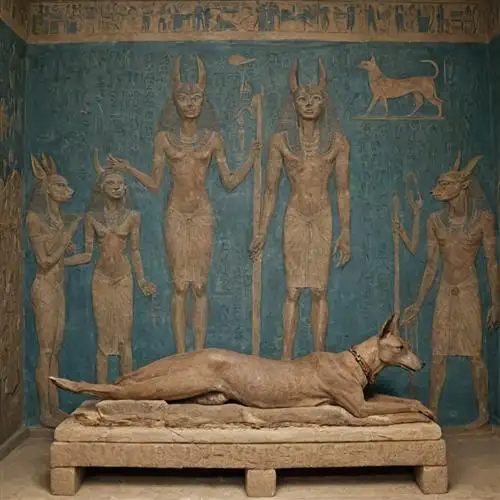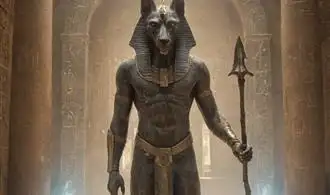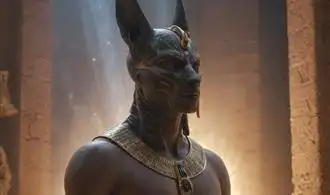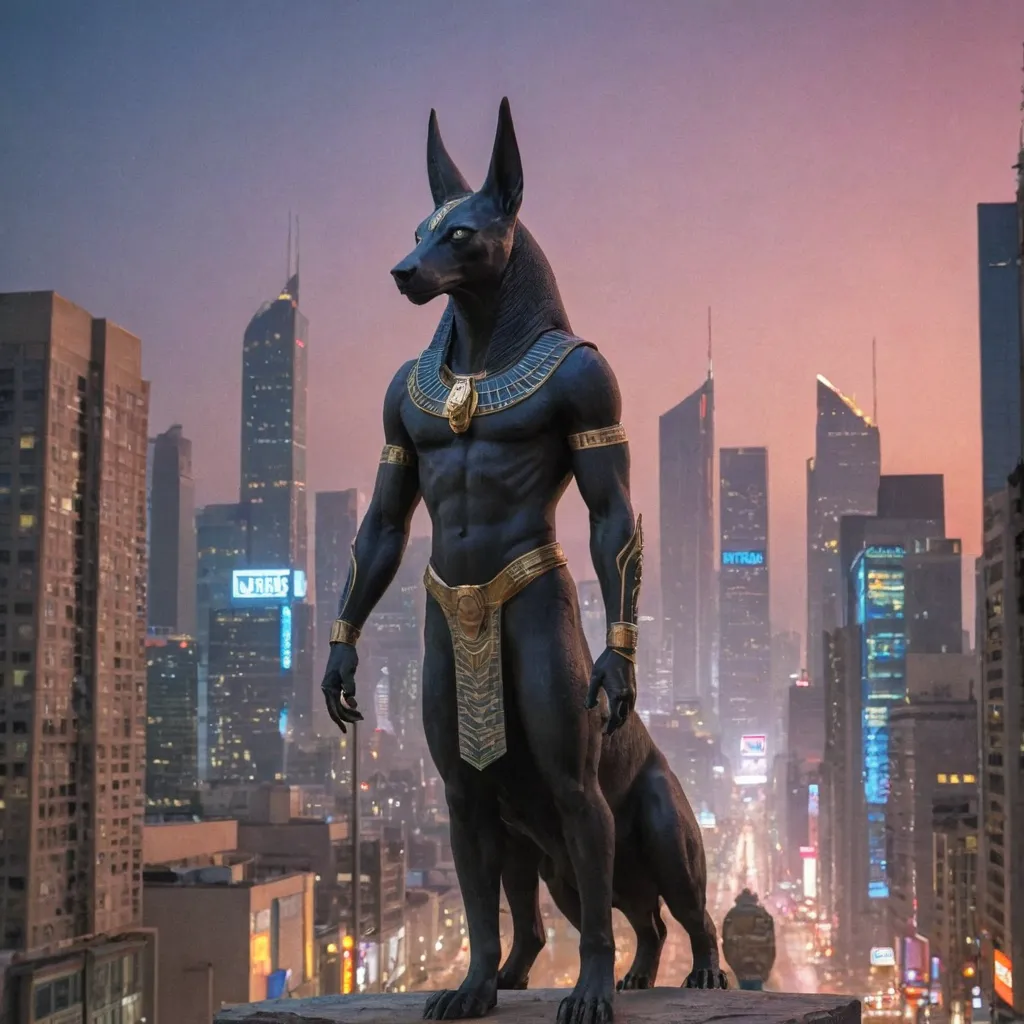
The Dual Nature of Anubis
Anubis, the enigmatic jackal-headed deity of ancient Egypt, is often reduced to a one-dimensional figure associated solely with death and the afterlife. However, this perception fails to capture the true complexity and duality that define this powerful god. Anubis' role extended far beyond the realm of the dead, encompassing a range of responsibilities and symbolism that showcase the depth and nuance of his divine persona.
At the core of Anubis' dual nature lies his role as both a guardian of the dead and a protector of the living. In his capacity as the god of mummification and the necropolis, Anubis was responsible for guiding the souls of the deceased through the treacherous journey to the afterlife. He oversaw the intricate process of embalming, ensuring the preservation of the physical body to serve as a vessel for the spirit. This aspect of Anubis' identity is well-documented and widely recognized, as he was a central figure in the rituals and beliefs surrounding death and the afterlife in ancient Egyptian culture.
Yet, Anubis' influence extended beyond the realm of the dead, as he was also revered as a protector of the living. In this capacity, Anubis was believed to safeguard individuals and communities from harm, both physical and spiritual. He was invoked to ward off evil spirits, to provide guidance and wisdom, and to ensure the well-being of the people. This protective aspect of Anubis' nature is often overlooked, but it was an integral part of his divine portfolio in the minds of the ancient Egyptians.
The duality of Anubis' character is further exemplified in his symbolic associations. While he is commonly depicted with the head of a jackal, a creature often associated with death and decay, Anubis also embodied the qualities of loyalty, devotion, and vigilance. The jackal was revered for its keen senses and its ability to navigate the treacherous spaces between the realms of the living and the dead, making it an apt symbol for Anubis' role as a mediator and guide.
Additionally, Anubis' connection to the color black, which was symbolic of both death and regeneration in ancient Egyptian cosmology, reinforces the inherent complexity of his divine persona. Black was the hue of the fertile soil along the Nile, a source of life and sustenance for the Egyptian people. In this sense, Anubis' association with the color black can be seen as a representation of the cyclical nature of existence, where death is not an end but a necessary transition to a new phase of being.
The Symbolism of Anubis' Jackal Form
Anubis, the ancient Egyptian deity associated with the afterlife, is often depicted with the head of a jackal. This canine-like form holds a deep symbolic significance that sheds light on the complex and multifaceted nature of this revered deity. Delving into the symbolism of Anubis' jackal form provides a deeper understanding of his role in the Egyptian pantheon and the beliefs surrounding the journey of the dead.
The jackal, a cunning and adaptable predator, was a fitting choice to represent Anubis, the god who guided the deceased through the challenging transition to the afterlife. Jackals were known to roam the deserts and graveyards, scavenging for food, and were often associated with the liminal spaces between the world of the living and the dead. This connection to the liminal realm made the jackal an apt symbol for Anubis, the gatekeeper between the mortal and divine realms.
Moreover, the jackal's keen senses and ability to navigate the darkness of the night were seen as reflective of Anubis' role as the protector and guide of the dead. Jackals were believed to possess the ability to traverse the underworld, leading souls to their final resting place, just as Anubis was tasked with overseeing the funeral rites and guiding the deceased through the treacherous journey to the afterlife.
The black color of Anubis' jackal form also held deep symbolic significance. Black was associated with the fertile and regenerative power of the Nile River, as well as the color of the mummified body, symbolizing the process of death and rebirth. Anubis' black complexion, therefore, represented his role as the overseer of the embalming process and the guardian of the dead, ensuring their successful transformation and transition to the afterlife.
Furthermore, the jackal's association with the underworld and the realm of the dead was further reinforced by the fact that these animals were known to scavenge and feed on the decomposing bodies of the deceased. This grim yet essential aspect of the natural cycle was viewed by the ancient Egyptians as a necessary part of the journey to the afterlife, and Anubis, in his jackal form, became the embodiment of this process.
Anubis and the Mummification Process
Anubis, the enigmatic jackal-headed deity, has long been a subject of fascination and misunderstanding within the realm of ancient Egyptian mythology. As the god associated with the mummification process, Anubis's role was of paramount importance in the preparation of the deceased for their journey into the afterlife. However, the true depth and significance of this deity's responsibilities are often overlooked or misinterpreted.
At the heart of Anubis's involvement in the mummification process lies a profound understanding of the delicate balance between life and death. As the gatekeeper of the underworld, Anubis was tasked with guiding the deceased through the intricate rituals that would ensure their successful transition into the afterlife. This responsibility was not merely a matter of preserving the physical body, but rather a sacred duty to safeguard the soul's journey and facilitate its integration into the divine realm.
The mummification process, overseen by Anubis, was a meticulous and multifaceted endeavor that went far beyond the simple act of embalming. It was a complex series of rituals and procedures that sought to not only preserve the physical form but also to imbue it with the necessary spiritual and magical properties to ensure the deceased's safe passage into the afterlife. Anubis's presence was a crucial component of these rituals, as his divine guidance and protection were believed to be essential in guiding the soul through the treacherous journey ahead.
Anubis's role in the mummification process was not limited to the physical aspects of preservation. He was also believed to be the guardian of the canopic jars, which contained the vital organs of the deceased. These jars were considered sacred vessels, housing the very essence of the individual, and Anubis's watchful eye ensured their safe keeping and proper placement within the tomb. Additionally, Anubis was responsible for weighing the heart of the deceased against the feather of truth, a crucial step in the judgement of the soul before it could enter the afterlife.
The significance of Anubis's involvement in the mummification process cannot be overstated. He was not merely a passive observer, but an active participant in the intricate dance between life and death. His presence throughout the entire ritual served to imbue the process with a divine purpose, ensuring that the deceased would be properly prepared and protected for their journey into the unknown.
Anubis as the Weigher of Souls
Anubis, the Egyptian deity associated with mummification and the afterlife, is often misunderstood and underappreciated. One of his most significant roles is that of the Weigher of Souls, a responsibility that sheds light on his complex and multifaceted nature. In this article, we'll delve deeper into this aspect of Anubis, exploring its significance and the insights it provides into the ancient Egyptian belief system.
As the Weigher of Souls, Anubis played a crucial role in the afterlife judgment process. During the famous "Weighing of the Heart" ceremony, the deceased's heart would be placed on one side of a scale, while the feather of Maat, representing truth and justice, would be placed on the other. Anubis, the god with the jackal head, would carefully observe the proceedings, ensuring the balance was maintained and the heart was pure.
This ritual held immense importance in the ancient Egyptian worldview. The heart was believed to be the center of the individual's emotions, intellect, and moral character. If the heart was found to be heavier than the feather, it was deemed unworthy, and the individual's soul would be devoured by the monstrous Ammit, a creature with the head of a crocodile, the body of a lion, and the hindquarters of a hippopotamus.
However, if the heart was found to be in balance with the feather, the deceased would be granted access to the afterlife, where they would join the divine company of the gods and the blessed dead. Anubis's role as the Weigher of Souls was, therefore, not just a ceremonial duty but a crucial step in determining the fate of the individual's eternal existence.
Anubis's association with this judgment process reflects the ancient Egyptians' deep reverence for truth, justice, and the sanctity of the individual's moral character. As the guardian of this sacred ritual, Anubis was seen as a deity of great power and authority, responsible for ensuring the proper balance between the physical and spiritual realms.
Anubis in the Modern Imagination
Anubis, the jackal-headed god of death and the afterlife, has captivated the imagination of modern audiences for centuries. Despite his prominent role in ancient Egyptian mythology, Anubis remains one of the most misunderstood deities of the Egyptian pantheon. This is largely due to the misconceptions and misrepresentations that have arisen in popular culture, often reducing Anubis to a simplistic symbol of death and the macabre.
In the modern imagination, Anubis is frequently depicted as a dark, sinister figure, associated with the more morbid aspects of death and the underworld. However, this one-dimensional portrayal fails to capture the depth and complexity of Anubis's role in ancient Egyptian beliefs. As the Why Anubis Remains a Powerful Icon in Ancient Egypt, Anubis was a multifaceted deity who played a crucial role in the afterlife, guiding the souls of the deceased and ensuring the proper preservation of the body through mummification.
Moreover, Anubis was not solely associated with death and the underworld; he was also revered as a protector, a guardian, and a facilitator of the transition from life to the afterlife. His jackal-like appearance, which likely symbolized his connection to the natural world and the cycle of life and death, has often been misinterpreted as a representation of darkness and evil.
In recent years, however, there has been a growing recognition of the need to understand Anubis within the context of ancient Egyptian beliefs and practices. Scholars and enthusiasts alike have made concerted efforts to explore the nuances of Anubis's role and to dispel the misconceptions that have long surrounded this enigmatic deity.


